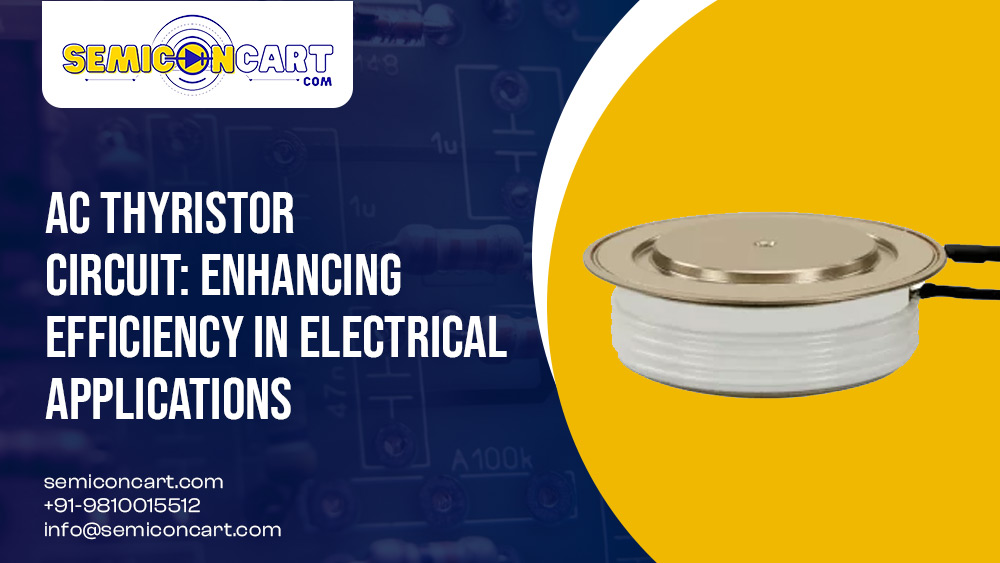AC Thyristor Circuit: Enhancing Efficiency in Electrical Applications
In the realm of electrical engineering, the AC thyristor circuit stands out as a cornerstone technology, revolutionizing the way power is controlled and distributed in various applications.

In the realm of electrical engineering, the AC thyristor circuit stands out as a cornerstone technology, revolutionizing the way power is controlled and distributed in various applications. With its ability to handle high voltage and current levels while offering precise control over power flow, the AC thyristor circuit has become indispensable in industries ranging from manufacturing to renewable energy. In this comprehensive guide, we delve into the intricacies of AC thyristor circuits, exploring their components, functionalities, and the role they play in enhancing efficiency in electrical applications.
Understanding AC Thyristor Circuits
What is a Thyristor?
A thyristor, sometimes called a silicon-controlled rectifier (SCR), is a type of semiconductor device that functions as a switch, directing the flow of electrical current in a single direction. Unlike traditional mechanical switches, thyristors can manage high currents and voltages with minimal energy loss, making them perfect for heavy-duty applications.
Components of an AC Thyristor Circuit
An AC thyristor circuit typically consists of the following components:
Thyristors: These are the heart of the circuit, responsible for controlling the flow of alternating current (AC). Thyristors come in various types, including stud-type thyristors and capsule-type thyristors, each designed for specific voltage and current ratings.
Control Circuit: The control circuit governs the firing angle of the thyristors, regulating the amount of power delivered to the load. It may include pulse transformers, triggering circuits, and gate drivers to ensure precise control over the thyristors' switching behavior.
Load: The load is the device or system that consumes electrical power from the circuit. It could be anything from a motor or heater to a lighting system or industrial machinery.
Protection Circuitry: To safeguard the circuit and connected devices from overvoltage, overcurrent, and short circuits, protection circuitry such as fuses, circuit breakers, and surge suppressors are often incorporated into AC thyristor circuits.
Advantages of AC Thyristor Circuits
AC thyristor circuits offer several advantages over traditional switching methods:
Efficiency: Thyristors have low conduction losses and can switch rapidly, resulting in higher overall efficiency compared to mechanical switches.
Precision Control: By adjusting the firing angle of the thyristors, precise control over power delivery can be achieved, allowing for the optimization of electrical systems.
Reliability: Thyristors have a long operational lifespan and can withstand harsh operating conditions, ensuring reliable performance in demanding applications.
Compact Size: Compared to bulky mechanical switches, thyristors are compact and lightweight, making them suitable for integration into space-constrained environments.
Applications of AC Thyristor Circuits
AC thyristor circuits find extensive use across various industries and applications:
Industrial Automation
In industrial automation, AC thyristor circuits control the speed and torque of motors, regulate temperature in heating systems, and manage power distribution in complex machinery.
Renewable Energy Systems
In renewable energy systems such as wind turbines and solar inverters, AC thyristor circuits enable efficient conversion of AC power to DC for storage or grid integration.
Power Electronics
In power electronics applications, AC thyristor circuits facilitate the conversion, regulation, and distribution of electrical power in systems such as uninterruptible power supplies (UPS) and voltage regulators.
HVAC Systems
In heating, ventilation, and air conditioning (HVAC) systems, AC thyristor circuits regulate compressor speed, fan operation, and temperature control, enhancing energy efficiency and comfort.
Buying Thyristor Modules Online
With the increasing demand for AC thyristor circuits, purchasing thyristor modules online has become a convenient option for engineers, technicians, and hobbyists. Online platforms offer a wide range of thyristor modules from reputable manufacturers, allowing customers to compare specifications, prices, and reviews before making a purchase.
When buying thyristor modules online, consider the following factors:
Specifications: Ensure that the thyristor module meets the voltage, current, and power rating requirements of your application.
Quality: Choose modules from trusted manufacturers known for their reliability and performance.
Support: Look for sellers that provide technical support, documentation, and warranty options to address any concerns or issues.
Price: Compare prices from multiple sellers to find the best deal without compromising on quality.
By leveraging the convenience and accessibility of online platforms, engineers and enthusiasts can easily acquire the necessary components to build AC thyristor circuits for their projects and applications.
Conclusion
AC thyristor circuits mark a major step forward in power electronics, delivering exceptional efficiency, control, and reliability in various electrical uses. Their capacity to manage high voltages and currents while offering exact control over power flow makes them crucial in sectors like industrial automation and renewable energy. Knowing the parts, benefits, and uses of AC thyristor circuits allows engineers and hobbyists to fully leverage this transformative technology to boost efficiency and performance in their work.






